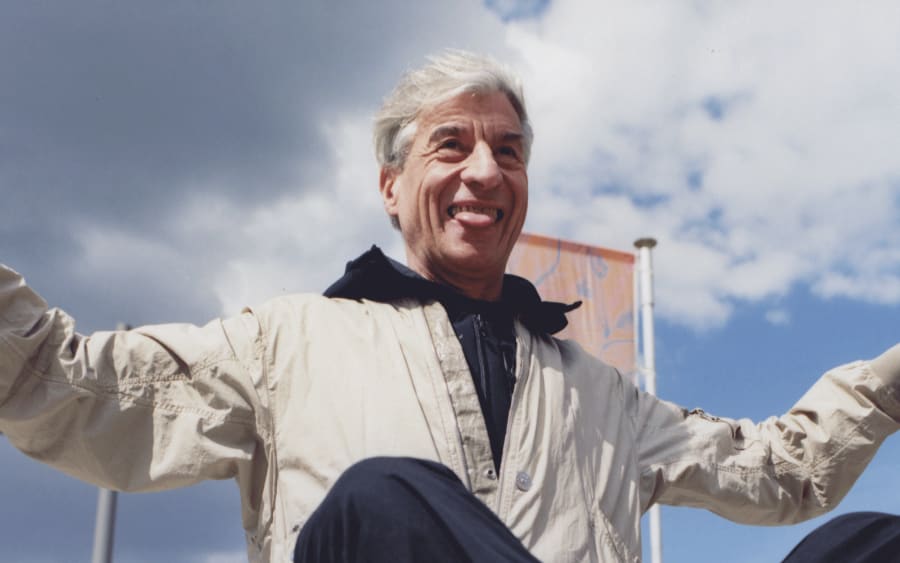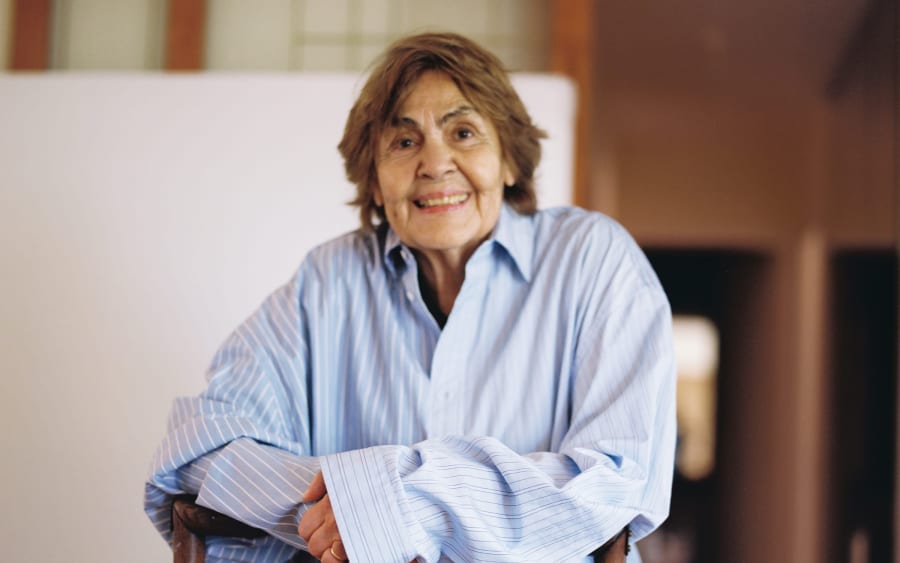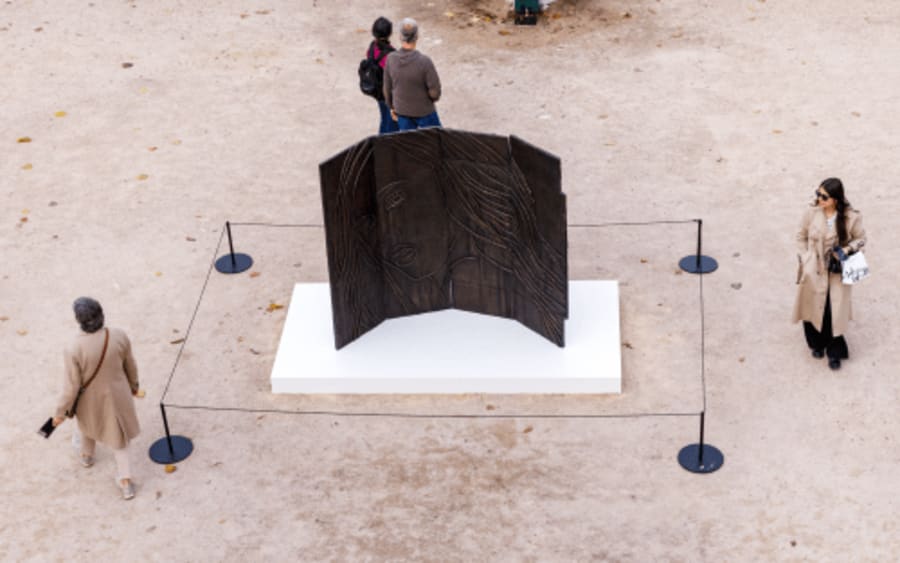Gods, demons, volcanoes, sunken cities, and artworld arch joker Maurizio Cattelan – at this year’s ʻPanorama,ʼ the earth ʻbreathes, rises and sinks, constantly reminding us of its unstable nature,ʼ explains Chiara Parisi, director at the Centre Pompidou-Metz and curator of the 2025 edition, which opens on September 10th. Asked why she decided to take on this ambitious venture – a five day exhibition with 47 artists that will wind its way through the 2500-year-old town of Pozzuoli, and its active volcanic caldera – she says: ʻI wanted to bring together a group of artists in a place in Italy they don’t necessarily know, to create an ephemeral land art project. Pozzuoli, with its mix of punk energy and romantic atmosphere, has always fascinated me.ʼ
Pozzuoli was founded as an ancient Greek colony in 531 BC and was the ʻHamptons of ancient Rome” where Cicero maintained a villa. The city, replete with Greek and Roman ruins, Baroque architecture, and volcanic calderas, is ʻan extraordinary venue that few Italians have even heard of, much less the touristsʼ explains Pepi Marchetti, the founding director of Gagosian Rome and co-founder of ITALICS, the network of 70 ancient, modern, and contemporary galleries that organizes ʻPanoramaʼ.
Deification, or apotheosis, the central theme of the exhibition, is the act or process of elevating a person, idea, or thing to the status of a god. Widely present as a motif throughout art history, but particularly in Greek and Roman art, it is particularly relevant to Pozzuoli. ʻThe Phlegraean Fields are a territory where myth became geography: the gods defeated the giants here, the lake of Averno was the gate to the underworld, the Solfatara the forge of Hephaestus,ʼ Parisi notes. ʻArtists wanted to engage with this energy. Some artworks were conceived in direct dialogue with the volcanoes and the traces of the land, amplifying the sense of a landscape that is itself a living artwork,ʼ she adds.
In the Flavian Amphitheater, with its echoes of imperial Rome, Clarissa Baldassari and Simone Fattal will reflect on power and spectacle; the historic quarter of Rione Terra, with its stratified ruins and the Duomo built over a Roman temple, lies at the heart of the project: a place where sacred and profane, ancient and modern, coexist. Some works were newly commissioned for these sites, such as a piece by Goshka Macuga that responds to a volcano, others are historical presences that reframe the idea of transcendence across centuries. ʻThere are thrilling dialogues between Elmgreen & Dragset and Sandra Vásquez de la Horra, and then you move through works by artists like Yuri Ancarani, Mario Merz, Simon Dybbroe Møller, Kevin Francis Gray, William Kentridge, Jannis Kounellis, Servane Mary, Rebecca Moccia, Ugo Rondinone, Simon Starling, and David Tremlett; alongside iconic figures such as Jan Vercruysse and Lawrence Weiner,ʼ Parisi explains. Artists are unified by their subject matter, often creating site-specific work, with materials such as rock, marble, and wood, thinking through what sculpture can be. Younger generations, represented among others by Oliver Beer, Giusy Pirrotta, Damir Očko, and Felix Shumba, respond to themes of archaeology, and myth, history, and identity.
The program unites contemporary artists with Roman sculpture dating to the 2nd century AD, as well as to painters and sculptors of the 17th and 18th centuries, such as Luca Giordano and Luigi Primo (Louis Cousin), and Matteo Bottigliero. Artists are drawn from galleries with both contemporary and historical rosters. ʻWe wanted to create projects spanning art of all times, growing an art-historical through line,ʼ Marchetti explains. Parisi worked with ITALICS member galleries to identify artists whose works resonated with the locations and the territory. ʻMy role was to weave these proposals into an overall vision, ensuring that the works were not simply “hosted” in Pozzuoli, but found a living connection with the place and the theme of deification.ʼ Lorenzo Fiaschi, co-director of Galleria Continua, and the director and co-founder of ITALICS, comments ʻUsually curators speak with artists; for “Panorama,” the meeting point is the gallery. It’s an exercise in building a bridge that emphasizes the galleries’ cultural role,” adding. ʻPanorama presents ancient, modern, and contemporary on one line – art isn’t “new” or “old.”ʼ Key elements of the programming are speakersʼ corners and public breakfasts. Held in intimate, everyday spaces, these events aim to bring artists, residents, and visitors into a shared artistic discourse outside an institutional setting. Artists and local inhabitants will be able to swap personal stories and interpretations of the work on display. ‘We hope these formats unlock unexpected conversations,ʼ says Parisi.
Founded in 2020, during the pandemic, when artists were struggling to maintain their practices, Fiaschi says ITALICS started from a passion for arts and culture: ‘Gallerists are not just people who sell art. You become a gallerist because you want to support artistic creation.’ Marchetti adds, ʻWe want to show that galleries are places of cultural production, not just shops or middlemen extracting value.ʼ ITALICS aims to show ‘Italy through gallerists’ eyes.ʼ To this end, in 2020, the group established ʻPanorama,’ which has taken place in a series of different, off-the-beaten-track towns. Fiaschi explains, ‘I discovered Procida, the first site, thanks to the artist Daniel Buren – he’s had a house there for more than 30 years. That combination – character, beauty, history, but not well known – was our spark. Each edition involves a new curator and starts from scratch in a new location. ‘Over time we’ve brought in private-sector sponsors and some support from local government, but it still takes enormous time and effort. On my team I have a couple of staff members, plus a producer, and their crew, all funded by the galleries,ʼ Marchetti says. ʻThe project is fragile. It depends on many variables and people. Today’s market climate makes things harder and puts the project into question.ʼ
But what makes an edition of ‘Panorama’ a success, beyond visitor numbers? After all, it’s not an art fair where galleries can sell works; it’s a UNESCO-supported cultural project. ‘The “profit” for galleries is renewed respect: communities and the country seeing galleries as cultural actors,’ Fiaschi explains. ‘You can’t tally the five-day costs and expect an immediate return,’ Marchetti notes. ‘My wish is to see “Panorama” everywhere, creating opportunities for older people, children – everyone – to share art. I want ordinary citizens to be touched by art.’ Fiaschi says enthusiastically.
Marchetti’s response is more tempered: ‘Lorenzo is the visionary – 10 ideas a minute. I’m the one who says, “Let’s be realistic. Let’s pick one idea and do it well.” We balance each other. There’s a lot we could do, and we’re being invited to expand the project both within Italy and internationally, but we need to grow organically.’’
Whatever the future holds for ‘Panorama,’ it will always remain in conversation with local communities.
Panorama Pozzuoli runs from 10 to 14 September 2025.
Dr. Jeni Fulton is Art Basel's Head of Editorial.
Caption for header image: Pozzuoli, Serapeum. Photo: Luciano Romano.
Published on September 9, 2025.


